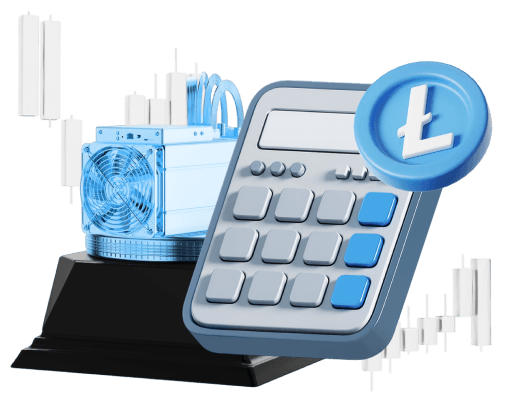How to Estimate Mining and Trading Profits using a Litecoin Calculator

Litecoin calculators are essential tools that help miners and traders make faster, more informed decisions. By providing estimates on profitability and value, they streamline the process of mining and investing in LTC. These calculators vary in type and function, from estimating mining rewards to calculating investment returns. This guide explores the different types of LTC calculators, how to use them, and strategies for maximizing your Litecoin profits.
What Is a Litecoin Calculator?
A Litecoin (LTC) calculator is a tool designed to quickly estimate the cryptocurrency's value and potential profitability. It helps users determine the monetary worth of their LTC holdings, track the current price, and calculate how much Litecoin they can purchase with a specific amount of fiat currency. This tool is especially useful for traders and investors, as it simplifies converting LTC to and from currencies like the USD or EUR, providing a clear picture of an investment's value.
Types of Litecoin Calculators
Several types of Litecoin calculators are available, each designed for a specific purpose.
Litecoin Mining Calculator
A mining calculator estimates the potential profit from mining Litecoin. It uses several key variables to provide an overview of expected earnings. Users input their mining hardware's hashrate (processing power), its power consumption in watts, local electricity costs per kilowatt-hour (kWh), and any mining pool fees. Based on these inputs and the current block reward, the calculator estimates your potential earnings on an hourly, daily, or monthly basis, helping you determine if your mining setup is financially viable.
Litecoin Profit Calculator
Also known as an investment calculator, this tool calculates the profit or loss from buying and selling Litecoin. To use it, you enter the amount of LTC purchased, the price at which you bought it, and the price at which you sold or intend to sell. The calculator then shows your total gain or loss, both as a monetary value and a percentage. This is ideal for traders and long-term investors tracking the performance of their assets.
Litecoin to Fiat Currency Converter
This is the most straightforward type of calculator, offering real-time conversions between LTC and fiat currencies such as USD, EUR, or NGN. By entering an amount in LTC, you can instantly see its equivalent value in your chosen currency, which is useful for checking the current worth of your holdings.
Litecoin Transaction Fee Calculator
This tool estimates the cost of sending LTC across the blockchain. The fee can fluctuate based on network congestion. The calculator analyzes the transaction size and current network conditions to provide an estimated fee in both LTC and USD, helping users manage transaction costs effectively.
Litecoin Tax Calculator
A tax calculator helps determine the taxes owed on capital gains from Litecoin transactions. It requires your complete purchase and sale history, along with region-specific tax regulations, to provide an accurate report for tax purposes. This is an essential tool for investors and traders who need to remain compliant with local laws.
Litecoin Savings Calculator
Also called an interest calculator, this tool estimates potential earnings from saving or staking LTC on lending platforms. By inputting the deposit amount, interest rate, and holding duration, it projects the interest you can earn over time, making it valuable for users looking to generate passive income from their crypto assets.
Top Litecoin Calculators to Use (Free & Trusted)
Several free and trusted Litecoin calculators are available online, each with unique features.
- Switchere: Offers a user-friendly and visually appealing calculator for quick conversions between LTC and fiat currencies, helping investors instantly assess the value of their holdings.
- CoinLedger: Provides a free tool for tracking crypto gains, losses, and income. It focuses on security, using end-to-end encryption to protect user data while simplifying tax reporting.
- CoinWarz: A comprehensive Litecoin mining calculator that allows users to input their hashrate or select their specific mining hardware from a preloaded list. It automatically includes current data like LTC price, block reward, and network difficulty for accurate profit estimates.
- Coincodex: Features a versatile profit calculator that can project future Litecoin earnings based on an initial investment, regular contributions (daily, weekly, etc.), and a specified rate of return over time.
Key Factors That Affect LTC Profitability
The profitability of mining or trading Litecoin is not constant and is influenced by several key factors.
For miners, the hash rate of their hardware is crucial; a higher hash rate increases the chances of solving a block and earning rewards. Electricity costs are also a major factor, as mining is energy-intensive, and high power bills can erase profits.
For both miners and traders, market dynamics play a significant role. The price of Litecoin is driven by supply and demand—high demand with limited supply pushes prices up, while a surplus can cause prices to fall. External events, such as positive or negative news, can also impact investor sentiment. For example, reports of a security breach can trigger sell-offs, whereas news of wider adoption can boost prices.
Government policies and broader economic conditions are also influential. Favorable regulations can build investor confidence, while restrictive laws can hinder growth. Economic indicators like inflation and interest rates can also affect the overall financial markets, including cryptocurrency.
Tips to Maximize Litecoin Profits
Maximizing profits from Litecoin requires a clear strategy, as market volatility can make timing sales difficult. No single rule applies to everyone, but a common approach is to take profits incrementally. Selling portions of your holdings at different price points helps lock in gains while allowing you to benefit from potential future price increases.
For beginners or risk-averse investors, Dollar-Cost Averaging (DCA) is a popular strategy. This involves buying a fixed amount of Litecoin at regular intervals, regardless of price, and similarly selling small amounts over time. This method mitigates the impact of market volatility. More experienced traders might engage in more aggressive buying and selling based on technical analysis. They often watch for specific market indicators, such as chart patterns, to signal potential price drops and identify optimal times to sell.
How to Get Started with Litecoin on Switchere
Getting started with Litecoin on a platform like Switchere is a straightforward process.
First, create an account by providing the necessary details. Once your information is verified, you can deposit funds and begin trading. To fund your account, you can deposit Litecoin directly or use a credit or debit card to purchase it instantly. Switchere supports secure transactions for buying and selling various cryptocurrencies.
If your account holds a currency other than LTC, you can use a trading pair to acquire it. Common pairs include LTC/USDT, LTC/BTC, or LTC/USDC. Select the relevant pair to exchange your existing currency for an equivalent amount of LTC. After that, you can place a market or limit order based on your trading strategy. Finally, for long-term holding, it is recommended to set up a secure Litecoin-compatible wallet. Options include hardware, mobile, web, or paper wallets, each offering different levels of security and convenience.
Frequently asked questions
-
What is a Litecoin calculator?
A Litecoin calculator is a tool that helps miners and investors estimate potential profits, convert LTC to fiat currency, and assess the value of their holdings. -
How do I calculate Litecoin mining profitability?
To calculate mining profitability, you need to input your hardware's hash rate, power consumption (in watts), electricity cost (per kWh), and any mining pool fees into a Litecoin mining calculator. It will then estimate your potential earnings over various timeframes. -
What is the difference between a mining calculator and a profit calculator?
A mining calculator estimates potential earnings from the process of mining LTC by analyzing hardware performance and operational costs. A profit calculator determines the financial gain or loss from buying and selling LTC as an investment. -
Are Litecoin calculators accurate?
Litecoin calculators provide estimates based on the data you provide and current market conditions. While they are valuable for planning, the results are not guaranteed, as market variables can change quickly. It is wise to consult multiple sources for a clearer picture. -
Where can I buy Litecoin?
You can buy Litecoin on various cryptocurrency exchanges like Switchere.com. These platforms typically allow purchases using credit/debit cards, bank transfers, or by exchanging other cryptocurrencies.
